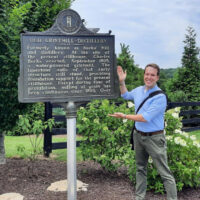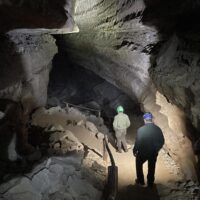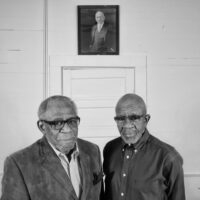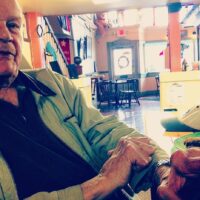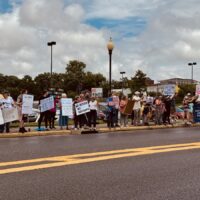In the interlude between World War II and the Korean War, American joy and exuberance arrived in the form of organized community baseball in Wildie, College Hill, Ford, Waco, Kirksville, Ravenna, and Bearwallow — all mere wide places on Central Kentucky’s backroads.
The Tobacco League, as this predominantly rural baseball circuit was called, was as earthy and organic as the name suggests. From 1949 to 1951, tiny communities fielded teams to compete with Berea, Richmond, and Lexington clubs for regular-season and playoff titles. Games were played on Sunday afternoons from May to September — roughly the same time it took light-leaf tobacco farmers to transplant, grow, and harvest their crops.

Play ended abruptly after the 1951 season when the Tobacco League could no longer compete with the Korean War’s demand for the same draft-eligible men. According to a news article before the 1951 season, “Only six teams, instead of the usual eight, will play this year. The drafting of young boys is the cause.” America’s pastime soon gave way to America’s heightened obsession with communism.
My father, Billy Hiatt, played shortstop for the Wildie Rockies, and although Tobacco League lore and memorabilia were central to my youth, I’ve come to appreciate his photographic archive as his most enduring contribution to the game. His images captured a unique moment when the country paused to catch its breath after more than two decades of Depression-era and wartime privation.

Visual culture scholars understand photos not as neutral purveyors of reality but as reflections of the values, beliefs and experiences of the photographer. By no means a professional (he probably used a consumer-level Kodak Brownie Reflex), my father’s documentarian eye imbued his photos with a distinct sense of time and place. Even in the moment, his impulse was to curate the events and memories of a community in which he was related to half the population and saw the other half almost daily in his father’s general store and post office.
While it’s easy to see these images as moments suspended in a simpler past, in reality, the photos anticipate the upheaval and loss then confronting rural communities. Like postwar America more broadly, rural Kentucky was in flux. Besides Korean War service, Kentuckians were leaving to attend college, marry and start families, and seek factory jobs in Ohio and Indiana during one of the largest economic expansions in history. Outmigration altered the social and cultural fabric forever.
The First Pitch

Following a disorganized trial season in 1948, the Tobacco League was officially formed in January 1949 with a constitution seeking “the furtherance of the game of baseball in Madison County,” home to the majority of teams. Fayette, Clark, Estill, Garrard, and Rockcastle counties also fielded clubs at various times. League founder Fred Engle Jr. served as president. Seasons were 28 games, ending with a four-team, best-of-3 playoff for the Kessler Jewelry Trophy. Teams were permitted up to 18 players, a manager, and two coaches, and could make roster changes until July 4. Clubs forfeited if not on the field 45 minutes after the scheduled start, but they could play with eight men if necessary.
Alliteration was the nickname fashion of the day (Bearwallow Bears, Berea Barons, County Clippers, Ravenna Ravens, Richmond Redbirds), but quaintness was also popular (Wildie Rockies, Waco Cardinals, Central Scarlets, Kirksville Blue Jays, Richmond Lads, College Hill Hilltoppers). The Hackley Sabres of Garrard County joined the final year.
Although money was tight, players and fans had time for leisure and a longing to forget about war, fleeting though it was. Wildie, located on the L&N railroad line off U.S. 25 in Rockcastle County, played in a cow pasture on the other side of the tracks. Crowds swelled into the hundreds. Beloved Wildie character Red Guthrie collected the admission of 25 cents for adults and 15 cents for kids and dropped the change into a cigar box.
The Mt. Vernon High School pep band traveled the 10 miles or so from the county seat to play for one Wildie season-opener, most likely arranged because my father and his brother, Jack, happened to be dating — and would soon marry — girls in the band.
Play Ball

Tobacco League baseball was the game distilled into its purest essence. Balls that rolled into the creek were put back into play dripping wet. My father told the story of teammate Rudolph Burdette, a future Rockcastle veterinarian, hitting a ball that kicked into foul territory past third base and rolled under a car. While the fielders circled the car looking for the ball, Burdette circled the bases and scored.
As the contemporaries of Ted Williams, Yogi Berra, and Mickey Mantle, the players mimicked the baseball card poses of the major-league greats — in a line with bats symmetrically on the shoulder, a paused follow-through of a swing, alternately serious or smiling depending on what degree of swagger they wished to convey.
My father, who was 20 when play began, cherished everything about the Tobacco League. Besides his photos, I inherited trophies from Wildie’s regular-season (1950, 1951) and playoff (1950) titles, uniforms, bats, gloves, scorebooks, schedules, newspaper clippings, letters, and other ephemera. He helped organize league reunions in 1969, 1989, and 1999. I recently found a satirical story he wrote about the day his best friend and Rockies catcher, Kelly Fish, strikes out in the bottom of the ninth, unleashing anger, grief, and community-wide suicide by creek and train.
More than a decade after his death, I appreciate the deep sense of the collective that permeates his images. Even the way he shared and circulated the photos aligned with his perception of them as artifacts to be used and consumed in the service of community. Shooting slide film enabled him to preserve 3 ¼-by-4 ½ prints in a scrapbook but also include Rockies images in church slide presentations that he and my mother produced even decades later.
Although his photos are deeply rooted in the specific time and place that made them meaningful to him, the images carry far beyond that context and prompt new reflections on change and stasis, significance and silence, and memory and meaning in our own lives.
I think he’d be happy sharing them.

This article first appeared on The Daily Yonder and is republished here under a Creative Commons license.
Willie Hiatt, who was born and raised in Mt. Vernon, Kentucky, is an Associate Professor of History at Long Island University, Post Campus, and a former Society for the Humanities Fellow at Cornell University. His teaching interests include how photographs shape history-making, construct identities and perceptions, and serve as tools of power and resistance. In his free time, he is a street photographer based in Queens, New York.

